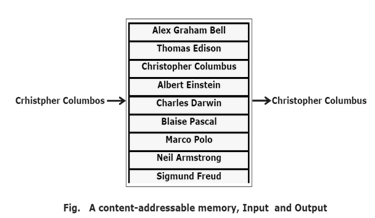SKEDSOFT
Introduction: - An associative memory is a content-addressable structure that maps a set of input patterns to a set of output patterns. A content-addressable structure is a type of memory that allows the recall of data based on the degree of similarity between the input pattern and the patterns stored in memory.
There are two types of associative memory: auto-associative and hetero-associative.
• An auto-associative memory retrieves a previously stored pattern that most closely resembles the current pattern.
• In a hetero-associative memory, the retrieved pattern is in general, different from the input pattern not only in content but possibly also in type and format.
Neural networks are used to implement these associative memory models called NAM (Neural associative memory).
An associative memory is a content-addressable structure that allows, the recall of data, based on the degree of similarity between the input pattern and the patterns stored in memory.
• Example: Associative Memory
The figure below shows a memory containing names of several people.

If the given memory is content-addressable, Then using the erroneous string "Christopher Columbus" as key is sufficient to retrieve the correct name "Christopher Columbus. “This type of memory is robust and fault-tolerant, because this type of memory exhibits some form of error-correction capability.
Associative memory is a system that associates two patterns (X, Y) such that when one is encountered, the other can be recalled. The associative memory is of two types: auto-associative memory and hetero-associative memory.
Auto-associative memory:-Consider, y[1], y[2], y[3], . . . . . y[M], be the number of storedpattern vectors and let y(m) be the components of these vectors,representing features extracted from the patterns. The auto-associativememory will output a pattern vector y(m) when inputting a noisy orincomplete version of y(m).
Hetero-associative memory:- Consider, we have anumber of key-response pairs {c(1), y(1)}, {c(2), y(2)}, . . . . . . ,{c(M), y(M)}. The hetero-associative memory will output a patternvector y(m) if a noisy or incomplete version of the c(m) is given.
Neural networks are used to implement associative memory models. The well-known neural associative memory models are :
· Linear associater is the simplest artificial neural associative memory.
· Hopfield model and Bidirectional Associative Memory (BAM) are the other popular ANN models used as associative memories.
These models follow different neural network architectures to memorize information.